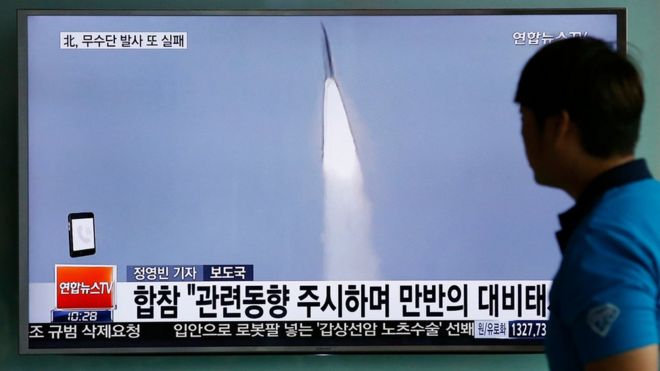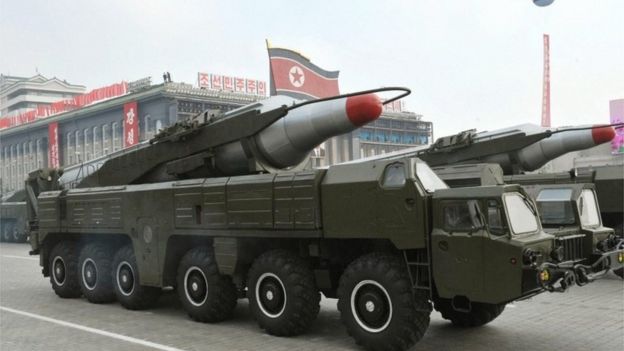- 17 minutes ago
- Asia
 AP
AP
North Korea has test-fired two mid-range ballistic missiles from its eastern coast, says South Korea.
The first launch was considered to have failed, travelling about 150km (90 miles) before landing in the sea.
The second, launched hours later, flew about 400km. Military officials in the South said both were intermediate-range Musudan missiles.
A confirmed successful test would mark a step forward for North Korea after four failed launches in recent months.
South Korea's Joint Chiefs of Staff said Seoul and the US were "carrying out an in-depth analysis" of the second launch, and did not say whether it was considered a success.
North Korea, which is developing nuclear weapons, is banned by UN resolutions from any use of ballistic missile technology.
- North Korea's missile programme
- Is South Korea equipped to defend itself?
- A world leader in dramatic rhetoric
- How potent are the threats?
South Korea's presidential office announced that it would hold a national security meeting to discuss the launch.
Analysis: Stephen Evans, BBC News, Seoul
North Korea has tested these medium range missiles six times now in three months. Outside experts and intelligence agencies believe the first five launches were certainly failures, but aren't sure about the sixth (today's second launch).
It seems to have gone about 400km (250 miles), far short of its maximum range. That may be because it failed or it may be because a decision was taken not to send it over Japan which had said it would shoot any missile down.
So why is North Korea conducting tests so frequently?
Some Western scientists say that the more conventional way of testing is to conduct the test, and if it fails, to go away and work out why before trying again some months or even a year later.
If this steady method over a long period isn't being followed by North Korea, it may be because of intense pressure from the top, a pressure the scientists on the ground will no doubt feel.
'Provocative actions'
The US State Department has strongly condemned the launches, with spokesman John Kirby saying the tests would only increase efforts to stop North Korea's weapons programme.
 EPA
EPA
"We intend to raise our concerns at the UN to bolster international resolve in holding [North Korea] accountable for these provocative actions," said Mr Kirby in a statement.
North American Defense Command (Norad), which tracked the missiles, determined they did not pose a threat to North American territories.
Japanese Prime Minister Shinzo Abe has said such tests "clearly cannot be tolerated".
The Musudan is believed to have a range of about 3,000km (1,800 miles), enough for it to hit South Korea, Japan and the US territory of Guam in the Western Pacific.
North Korea is thought to have dozens of them but has never successfully tested one.
The four other missiles tested in the last two months either exploded mid-air or crashed.
Surrounding countries had detected preparations for a launch in the past few days and warned that it was about to happen.
The Musudan missile
- The Musudan, also known as the Nodong-B or the Taepodong-X is an intermediate-range ballistic missile.
- Estimates differ dramatically on its range, with Israeli intelligence putting it at 2,500km and the US Missile Defense Agency estimating about 3,200km. Other sources put its upper limit at 4,000km.
- The lower range of the Musudan will enable it to hit the whole of South Korea and Japan. At its upper range it would be able to target US military bases on Guam.
- Its payload is unknown, but is estimated at 1.0-1.25 tonnes, according to AFP news agency.
Asia
China villagers rally behind held chief
- 21 June 2016
- China
Uproar over Salman Khan 'rape' comment
- 21 June 2016
- India



No comments:
Post a Comment